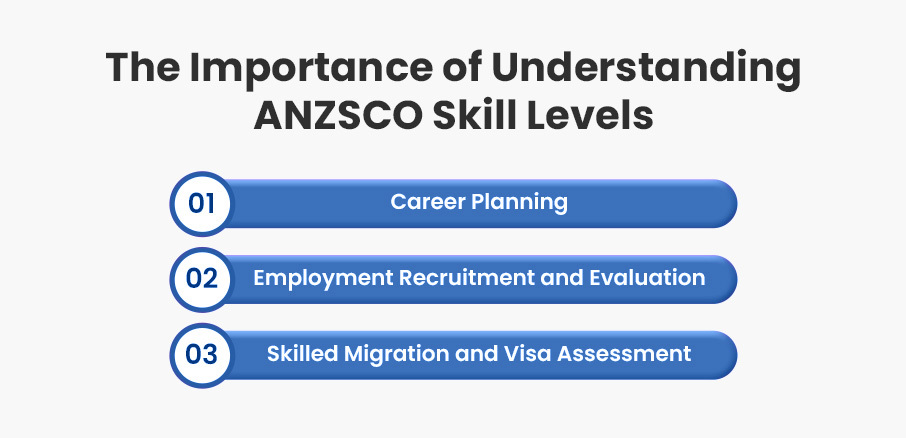
Understanding ANZSCO Skill Levels: A Comprehensive Guide
In today’s ever-changing job market, knowing skill levels is super important. It helps people move up in their careers; bosses pick the right employees; and immigration officers decide who gets visas.
The Australian and New Zealand Standard Classification of Occupations (ANZSCO) is like a rulebook. It helps sort and group different jobs based on how skilled they are and what they specialize in.
In this thorough guide, we’ll explore ANZSCO skill levels, why they matter, and how they impact various aspects of work and immigration.
What is ANZSCO?
The Australian and New Zealand Standard Classification of Occupations (ANZSCO) is a comprehensive classification system developed jointly by Australia and New Zealand. It helps organize jobs based on how skilled they are, what qualifications they need, and what tasks they involve. ANZSCO makes it simpler for individuals, employers, and policymakers to gather and exchange information about the job market. This helps everyone make better decisions about jobs and how to plan for the workforce.
What is the ANZSCO Code Skill Assessment?
The ANZSCO Code Skill Assessment is when experts make sure that someone’s qualifications and skills are right for a certain job. Each job has its special code in the ANZSCO system, kind of like a secret number. During the assessment, experts look at things like your education, work experience, and skills to see if they match what’s needed for that job’s code.
This assessment is usually done by important groups like immigration offices or professional organizations. They use it to decide if someone can get a visa to move to a new country for work or join special programs for skilled workers. It’s like a big test to make sure people have the right skills and qualifications for the job they want.
What are the ANZSCO Skill levels?
ANZSCO skill levels are categories used to classify occupations based on the expertise, qualifications, and experience required for specific roles.
The Five Skill Levels in ANZSCO
ANZSCO classifies occupations into five skill levels, each representing a different level of expertise, qualifications, and experience required for specific roles. Let’s explore each skill level in detail:
Skill Level 1: Occupations at ANZSCO Skill Level 1 require the highest level of expertise, qualifications, and experience. These jobs are typically found in professional or managerial roles, where a deep understanding, specialized skills, and extensive experience are essential.
Individuals in Skill Level 1 positions are expected to possess advanced knowledge and expertise in their respective fields, often leading teams or making critical decisions that impact the organization’s success. These roles demand individuals who have honed their skills through years of experience and possess the educational background necessary to excel in complex and demanding environments.
Examples of occupations at Skill Level 1 include doctors, software engineers, lawyers, and senior executives.
Skill Level 2: Occupations at Skill Level 2 need a moderate level of expertise and qualifications. These jobs often include technical, supervisory, or administrative positions that need special skills, the right qualifications, and hands-on experience.
Examples of occupations at Skill Level 2 include electricians, nurses, chefs, and office managers.
Skill Level 3: Jobs at Skill Level 3 need a Certificate III/IV or similar qualification, plus some training or experience on the job. These roles are in trades, technical work, or skilled labor, where you need a good amount of expertise in certain areas.
Examples of occupations at Skill Level 3 include carpenters, plumbers, hairdressers, and skilled machinery operators.
Skill Level 4: Occupations at Skill Level 4 require a Certificate II or III qualification and basic training or experience. These jobs include regular tasks and physical work that you can learn through training programs or while working on the job.
Examples of occupations at Skill Level 4 include factory workers, cleaners, farmhands, and retail assistants.
Skill Level 5: Jobs at Skill Level 5 are starting positions that don’t need much formal education and have simple tasks you can learn while working. These roles are for people just starting their careers or switching to new industries.
Examples of jobs at Skill Level 5 include positions like hotel staff, general laborers, office assistants, and retail salespeople.
The Importance of Understanding ANZSCO Skill Levels

Understanding ANZSCO skill levels is crucial for several reasons:
- Career Planning: ANZSCO skill levels help people understand what they need for different jobs. This helps them decide on their careers, see where they can get better, and find jobs that match what they’re good at and want to do.
- Employment Recruitment and Evaluation: Employers use ANZSCO skill levels to see if job applicants are qualified. This helps them pick the right people for each job and plan how to help employees grow in their careers.
- Skilled Migration and Visa Assessment: Immigration officers use ANZSCO skill levels to decide if people can move to a new country for work or other reasons.
ANZSCO skill levels help immigration officers compare foreign qualifications and work experience to standards in Australia and New Zealand. This makes sure that skilled migrants can add value to the local job market.
How to Determine Your ANZSCO Skill Levels

Determining your ANZSCO skill level involves assessing your qualifications, experience, and the requirements of your occupation as outlined in the ANZSCO classification. Here’s a step-by-step guide:
- Review ANZSCO Classification: Get a copy of the ANZSCO classification for your occupation from reliable sources such as government websites or official publications.
- Evaluate Qualifications and Experience: Check if your education, certifications, and work experience match what’s needed for your job in the ANZSCO classification. Look at the educational requirements, skills, and experience levels listed for your occupation.
- Seek Guidance if Needed: If you’re not sure if your qualifications and experience match the ANZSCO skill levels, ask experts or organizations who know about immigration and job assessments for advice.
- Document and Validate: Collect papers that show you’re qualified for your job, according to ANZSCO. Keep things like certificates, school records, and references from your jobs to prove your skills and experience.
- Submit Applications and Assessments: If you’re applying for skilled migration programs, work visas, or employment opportunities requiring ANZSCO skill level assessments, send your applications with all the required documents. Then, follow the assessment process set by the authorities or organizations in charge.
Understanding ANZSCO Codes
ANZSCO codes, also known as Australian and New Zealand Standard Classification of Occupations codes, are a standardized system used to categorize different jobs based on their skill levels, qualifications, and responsibilities.
These codes are essential for various parts of finding a job and moving to a new country, like Australia or New Zealand. They assist everyone, including job seekers, employers, and immigration officers, in understanding and assessing jobs more effectively.
How are ANZSCO Codes Used?
- Finding a Job: Employers use ANZSCO codes to describe job openings, so they can find the right people to hire. They also help job seekers understand what skills and qualifications they need for different jobs.
- Moving to a New Country: Immigration officers use ANZSCO codes to decide if someone is eligible to move to Australia or New Zealand for work. These codes help them compare qualifications and work experience from other countries to what’s needed in Australia and New Zealand.
- Understanding Job Trends: Governments and researchers use ANZSCO codes to analyze job trends and determine which skills are needed. This helps them plan for the future and create programs to train people for jobs that are needed.
Some of the famous positions with their ANZSCO Codes are ANZSCO 261111– ICT Business Analyst, ANZSCO 261211 – Multimedia Specialist, ANZSCO 262111 – Database Administrator, ANZSCO 263112– Network Administrator, etc.
How do I Find ANZSCO Codes?
ANZSCO codes can be found in official documents, government websites, and online databases. Job seekers, employers, and people applying for visas can look up these codes to learn more about specific jobs and what they involve. standards.
💡Learn more: ANZSCO Codes for different position
Conclusion
Understanding ANZSCO skill levels is crucial for career planning, recruitment, and visa assessments. ANZSCO gives a common way to organize jobs by expertise, qualifications, and experience, helping with decisions in hiring and immigration.
By familiarizing yourself with ANZSCO, assessing your qualifications, and seeking guidance, you can navigate the job market effectively. Continuous skill updating and professional development are vital for success.
This guide provides information about why ANZSCO skill levels are important and how they affect people, employers, and immigration officers. It helps make smart decisions about careers and move to new countries.
FAQs
- What are the ANZSCO skill levels?
- ANZSCO skill levels categorize occupations based on expertise, qualifications, and experience required for specific roles. There are five skill levels in ANZSCO.
- How are ANZSCO codes used in finding a job?
- ANZSCO codes help employers describe job openings and help job seekers understand the skills and qualifications needed for different jobs.
- How do ANZSCO codes assist in immigration processes?
- Immigration officers use ANZSCO codes to determine eligibility for moving to Australia or New Zealand for work, comparing qualifications and work experience.
- Where can I find ANZSCO codes?
- ANZSCO codes can be found in official documents, government websites, and online databases.
- How can I determine my ANZSCO skill level?
- Determine your ANZSCO skill level by assessing your qualifications and experience against the requirements outlined in the ANZSCO classification.
- Why are ANZSCO skill levels important?
- ANZSCO skill levels are crucial for career planning, recruitment, and visa assessments, helping individuals, employers, and immigration officers make informed decisions.
- What are the key steps in determining my ANZSCO skill level?
- Key steps include reviewing the ANZSCO classification, evaluating qualifications and experience, seeking guidance if needed, documenting and validating qualifications, and submitting applications along with assessments.





